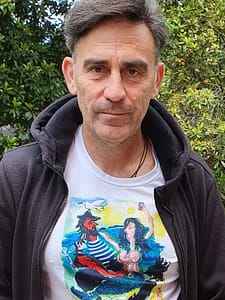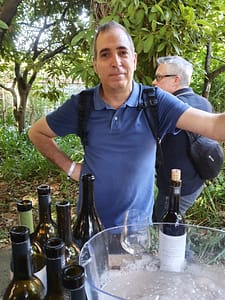Here is my second article from this year’s Simplesmente fair, where I present updates from producers that I already knew well. I tasted everything they offered, but I will try to restrict myself to presenting only a few wines.
(Read the first article from this year’s fair here, about some re-discoveries of wineries I knew a little.)
Antonio Portela from the Morrazo península, Galicia, Spain was a special guest this year. Chance had it that I started my tasting experience by his barrel. The occasion is a sad one, he is not able to continue his work for economic reasons. That means, if not anything unexpected happens we will not be able to taste his wonderful, fresh, saline wines anymore. Antonio has other activities to fall back on, such as writing and teaching, so he refuses to call the situation dramatic. Okay, but to call it a pity is to put it in a very careful way. The white (Mar do) Namorado he offered in the 2020 and 2018 vintages. It is a 85% loureiro, the rest albariño, espadeiro a.o., grown in sand on the beach. The 2020 had a light colour; aroma of citrus, flowers and yellow fruits; wonderful acidity and concentration, long with a salty aftertaste. The 2018, in comparison, had a honeyed edge, but still with plenty of acidity and concentration. The red tinta femia Namorado 2019 was light with red fruits (raspberry), a touch anise, and with a saline finish. The Namorado Berobreo 2019 was in the same line, light in colour and with a super acidity. This one was made with whole bunches.
Miguel Alfonso’s family has produced wine for generations in Val do Umia, in the Salnés part of Galicia. The current winery, Adega Pedralonga, was founded in 1997 by Miguel’s father Francisco, and biodynamic practises were implemented ten years later. Miguel says that the work is professionalized, but it follows the philosophy of the ancestors. This means they plough only when necessary, Also in the cellar they do as little as possible. Albariño is not de-stemmed, only natural yeasts are employed, malolactic fermentation is not blocked and all wines get an extended ageing on lees. The Pedralonga vineyards sit on granite soils and are influenced by an Atlantic climate, which very much shows in the wines.
Pedralonga 2021 is a classic, with its fresh aromas of citrus and flowers, wonderful texture, steely acidity, salt and a flinty mineral finish. One of the great whites of the fair. The same can be said of their Carolina 2021, made from caíño blanco, with a greenish hint, quince and herbs, unctuous with a grapefruity aftertaste. Tinto de Umia 2019 is light red with a bit of evolution, red fruits, a touch of smoke and a lovely acidity and a saline finish.
Alfredo Maestro operates in both his native Peñafiel (Ribera del Duero) and in Sierra de Gredos. Since 1998 he has vinifyed each plot according to its peculiarities, with native yeasts and without chemical products. The artisan practise continues in the cellar, where no machines are used. Wait a minute: Few machines are used. But I have seen on YouTube that Alfredo experiments with drones to do various work in the vineyard. A machine yes, but this is also to minimize the use of that sort.
Rey del Glam 2021 is an elegant example of the carbonic maceration garnacha. A mix from both Ribera and Gredos, it shows fragrant red fruits with licorice; juicy in the mouth, also with some structure. Almate 2021 Is an un-oaked Ribera: Dark cherry; red and wild fruits (cherry, blackberry); full-flavoured, yet with fine tannins. The skin-contact albillo mayor Lovamor 2021 and the partly flor-aged albillo mayor Consuelo 2020 delivered as usual. So did the speciality La Cosa / The Thing 2020, a sweet moscatel de alejandría. It’s interesting that someone makes a Cigales these days. Alfredo has an interesting garnacha gris called La Badi 2021, made with three days skin-contact. Therefore it achieves a light red colour with greyish hints (“ceniza y cigarro”, ash and cigar, Alfredo calls it). It’s a juicy glou-glou, truely fascinating. I have a crush on Rosado Clásico de Valladolid, now in its 2019 vintage. It’s in fact a clarete (in Spain made of red and white grapes, the same as a Portuguese palhete). It’s made with direct press, half in botas de Jerez, half in chestnut. The colour is pale red with an orange tinge, aromas of red berries (raspberry, plum), dried fruit and leather; the acidity and the alcohol (13,5) are integrated, while the tannins, fine-grained though, struggles to see if they can break out.
I visited Casa de Mouraz after 2017, the hot year with the devastating fires. (Read about the visit here.) They make fresh and inspiring Vinho Verde wines under António Lopes Ribeiro’s initials, alr. Here I choose a few Dão wines. Casa de Mouraz Encruzado 2020 is a perfumed varietal, with the extrovert fruit that the grape can offer, wonderfully balanced. Casa de Mouraz Palhete 2021, a field-blend of 80% red grapes, the rest whites, was light in colour, with concentrated raspberry and strawberry notes, an intense flavour and balanced acidity. Elfa 2017 made from 95 year old vines, with 30 different grape varieties co-planted. Worth mentioning is that there is no touriga nacional (not normal in Portugal, especially when there are that many varieties employed) and no oak. A red fruits- (cherry, raspberry) fruity wine with an underlying pine character; it has a fine structure and good balance. António also presented three wines without DOC, under the umbrella Planet Mouraz. The fact that they come without a DOC would most often mean that they are unfiltered. I tasted two vintages of the white Bolinha, namely 2021 and 2017. This is also a field-blend, fermented in stone lagar and stayed with skins for one week. The 2021 was clearly unfiltered; light golden, turbid; with an intense aroma of yellow fruits and herbs; grapey and full. The 2017 had a bit more colour; intense, with apricot and honey; quite big and full-flavoured, long and balanced. Bolinha is the name of the dog on the label, by the way.
It’s always a pleasure to meet José Perdigão, architect and vinegrower of Silgueiros, Dão, and taste his wines with labels by his wife Vanessa. A long-time favourite among his wines is the Quinta do Perdigão Rosé, now in its 2021 edition. It’s a rosé with some colour (José can maybe “arrest” me, but I would say somewhat less colour than before). It’s a full-flavoured rosé with aromas of raspberry and currant, and fresh acidity. Another classic from the house is the Alfrocheiro 2013: Dark cherry red with dark fruit aromas (blackberry, blueberry), pine; structured in the mouth, elegant, and very much alive after almost ten years. One that I don’t remember to have tasted is Noël 2015 (named after his youngest son). This is another wine that has kept well: Dark cherry; ripe red fruits (cherry, prunes); smooth, full of flavours. Still potential for ageing.
Lastly a trio from the Lisboa region. André Gomes Pereira and his Quinta do Montalto are actually found in the municipality of Ourém, in the Santarém district. But the wines are launched under neighbouring Lisboa’s regional.wines, if not DOC Encostas d’Aire (Medieval de Ourém). Pioneers in Portugal, since 1997, all crops at Quinta do Montalto are organic.
His medieval wine, a red and white blend, must be mentioned. This year I was in a hurry and skipped it though. I tasted his amphora wines for the first time. The vessels are made locally. Originally the manufacturer used epoxy. André said that this is “cheating” and against tradition. He said to André, why don’t you do it yourself? Then, as a statement, André decided that he would himself coat the amphoras with resin. Ánfora de Baco 2021 white is a varietal fernão pires, made 30% with skins and 3 months ageing with skins and on lees. Golden colour; flowers, resin and yellow fruits; full on the palate, fresh and Atlantic. The red equivalent with the same name is made from equal quantities trincadeira and aragonêz. Garnet red; red fruits (cherry), stonefruit (plums); super acidity and salinity. Cluricun Skin 2021 from grape varieties siria and fernão pires, 3 months on skins, was a peculiar wine. Pale amber colour; aroma of clementine and nuts; medium-bodied, with a light tannic grip.
Pedro Marques of Vale da Capucha (Turcifal, Torres Vedras) is a top producer, right there up with the very best. I could have mentioned all his wines. I will not, but I can say that they are focused, elegant and shaped by the terroir. The vineyards are planted on kimmeridgian limestone with clay. The white Fossil 2017 sums it all up. The name tells the story of a winery only 8 kilometers from the coast, in earlier times under water. Fossil has a light golden colour; aroma of citrus, white flowers, wax, chalk; a mineral taste, quite full and with a super integrated acidity. A lovely wine at a very nice price. Vale da Capucha Arinto 2019 is for me a star among his varietal wines. It’s light yellow; concentrated aromas of citrus (lemon and peel), yellow pepper, chalk; medium full in the mouth, mineral, with a lovely integrated acidity. Vale da Capucha Palhete 2019 is a blend of the white arinto and the red castelinho, made by “inking” a white wine with the red castelinho, then co-fermented in steel before bottling. Light red; red fruits (raspberry), salt; juicy, carefully structured.
Baías e Enseadas is located in Codiceira, Colares country, west of Lisboa capital. They have a more mature style. Daniel Afonso says, “I want to extract all I can from the skins”. The white Fernão Pires 2020 had stayed 6 months in barrel, with a lot of batonnage. -I always have acidity, says Daniel, now I want to work on the creaminess. And yes, a creamy texture together with a good acidity was achieved here. The Escolha Pessoal 2020 could be found along the same path, though a bit more concentrated and also elegant. Castelão 2020 showed mature fruits, alongside flowers and a hint licorice; juicy and quite complex, and a fruity finish.
Leave a Comment


































